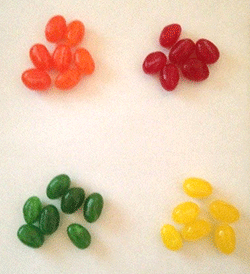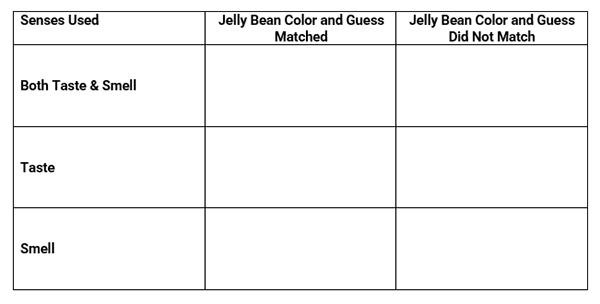

Have you ever wondered why you feel as though you can taste a delicious dinner cooking in the oven, just from the smell when you walk into the kitchen? Or why, when you're sick with a stuffy nose, food doesn’t taste as good anymore? In this experiment† we will learn about why this happens. |
|
| WHAT YOU WILL NEED | |
Supplies:
One of the goals of this experiment is to learn how our senses of smell and taste interact to form impressions of what we eat, as well as of the world around us. You will explore this phenomenon by observing whether jelly beans taste different when we use taste and smell together, compared to just taste or just smell alone. Before you start, recruit a friend and gather the supplies.
Place the beans on a table in front of you. Explain to your friend that you need them to help you taste the jelly beans. Put the blindfold on. Have your friend hand you one jelly bean without telling you what color it is. Chew and eat the jelly bean. Guess the color or flavor (both can be used as identifiers) of the jelly bean, telling your partner so that they can record a tally mark in the appropriate column in the data table, using the “Both Taste and Smell” row. Repeat this process for several different jelly beans. |
|
|
|
Next, leave the blindfold on and pinch your nose closed with your fingers. Now, you will try to guess the color or flavor using only your sense of taste. Have your friend hand you a jelly bean without telling you the color. Chew and eat the jelly bean, keeping your nose pinched closed until you have made your guess. Your friend should record your observations in the “Taste” row of the table, similar to what was done in the previous row. Finally, you will try to guess the color or flavor using only your sense of smell. Keep the blindfold on and crush the next jelly bean by rubbing it between your fingers. Hold the crushed jelly bean up close to your nose to get a whiff of its smell. Make your guess as to the color or flavor of the jelly bean you are smelling and ask your friend to tally the observations in the “Smell” row of the table. Repeat for several colors of jelly beans. Once you are finished guessing based on smell, remove your blindfold and switch roles with your friend so they can try to the experiment too! Once both you and your friend have tried the experiment, think about what you observed. Did your guesses match the actual color or flavor? Review the tallies of your reported observations and discuss what you have learned from this experiment. |
|
People can guess the correct jelly bean color or flavor more often when they use both taste and smell together. This demonstrates that taste and smell are intimately related. We are used to thinking of tasting food as only using the taste buds in our mouth, but as we chew, aromas are released from the food and circulate to the millions of receptors in our nose through the connection at the back of our throat. Therefore, our sense of smell is really important for enjoying the taste of our food! Each aroma, or smell, is related to the distinct flavor of the food we are eating. When you crush the jelly beans this action releases the smell aromas in a similar way to when you are chewing. When we are sick, or pinch our nose closed, the air with these food aromas can’t reach the nose because there is no way for the air to move or flow out. When our sense of smell is shut down, our brains receive drastically less information about the food we eat. The lack of information causes the food to taste more bland. On the other hand, when we smell food cooking, our brain also relates this scent to the taste that often comes with the same smell when we chew the food. Can you think of a time when the smell of dinner was wafting through the house and you could almost taste the food that was cooking? Your brain is filling in the missing information that usually comes with the smell as you eat. Here are several other experiments to learn more about how taste and smell interact: Did the color or flavor of the jelly bean affect how different it tasted when you couldn’t smell it? You can also use other foods with this same experiment. What if you hold a strong-smelling substance near your nose, such as peppermint, while eating a food that doesn’t normally have that smell? Does it change the taste of the food? |
|
| SOURCES & FURTHER READING | |
†Adapted from Scientific American’s “Savory Science: Jelly Bean Taste Test”
|

